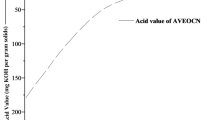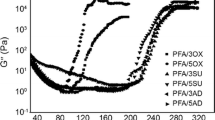Abstract
Two resins were prepared from Stipa tenacissima L. and their physical and chemical behaviors were evaluated. The resins were produced by modification of extracted lignin from the S. tenacissima L. using phenolation reaction (resorcinol). Glyoxal and formaldehyde as cross-linking agents were employed to produce lignin–glyoxal resin and lignin–resorcinol–formaldehyde resins (LRFR), respectively. The curing process of two lignin-based resins (lignin–resorcinol–glyoxal, LRGR, and lignin–resorcinol–formaldehyde, LRFR) was studied by rheological measurements and differential scanning calorimetry (DSC) techniques, which showed that the gel formation obeys an isoconversional principle. In fact, an analysis on curing kinetics was performed by processing its non-isothermal DSC data using Ozawa’s isoconversional methods and found that good fittings could be obtained. This method allowed the determination of activation energy and the pre-exponential factor dependencies on the degree of curing. In kinetics method, the variation in activation energy, evaluated at different curing degrees, revealed that the mechanism of phenolic resins is based on two reactions: methylolation followed by condensation. Finally, the gel points of these systems were found to be around 63 and 72 %, for LRFR and LRGR, respectively. These values were compared to those calculated from Flory and Stockmayer equation and found to be close to each other.






Similar content being viewed by others
References
Wen JL, Kuo C, I-Min T (2012) Properties of phenol-formaldehyde resins prepared from phenol-liquefied lignin. J Appl Polym Sci 124:4782–4788
Donohoe B, Decker S, Tucker MP, Himmel M, Vinzant T (2008) Visualizing lignin coalescence and migration through maize cell walls following thermochemical pretreatment. J Biotechnol Bioeng 101:913–925
Keshwani D, Cheng J (2010) Modeling changes in biomass composition during microwave-based alkali pretreatment of switch grass. J Biotechnol Bioeng 105:88–97
Lawther JM, Sun RC, Banks WB (1996) Characterization of dissolved lignins in two-stage organosolv delignification of wheat straw. J Wood Chem Technol 16:439–457
Lora JH, Glasser WG (2002) Recent industrial applications of lignin: a sustainable alternative to nonrenewable materials. J Polym Environ 10:39–48
Wang MC, Leitch M, Xu CB (2009) Synthesis of phenol–formaldehyde resol resins using organosolv pine lignins. Eur Polym J 45:3380–3388
Fengel D, Wegener G (1983) Wood: chemistry, ultrastructures, reactions. Springer, Berlin
Paiva JMF, Frollini E (2006) Unmodified and modified surface saisal fibers as reinforcement of phenolic and lignophenolic matrices composites: thermal analyses of fibers and composites. J Macromol Mater Eng 291:405–417
Wescott JM, Traska A, Frihart CR, Lorenz L (2005) Competitive durable soy-based adhesive dispersions. Proc Wood Adhes 2–4:263–269
Lorenz L, Frihart CR, Wescott JM (2005) Analysis of soy flour/phenol-formaldehyde adhesives for bonding wood. Proc Wood Adhes 2–4:501–505
Hong L, Pizzi A, Guanben D (2008) Environmentally friendly mixed tannin/lignin wood resins. J Appl Polym Sci 107:203–209
El Mansouri NE, Pizzi A, Salvado J (2007) Lignin-based polycondensation resins for wood adhesives. J Appl Polym Sci 103:1690–1699
Truter P, Pizzi A, Vermaas H (1994) Cold-setting wood adhesives from kraft hardwood lignin. J Appl Polym Sci 51:1319–1322
Yu H, Mhaisalkar SG, Wong EH (2005) Observations of gelation and vitrification of a thermosetting resin during the evolution of polymerization shrinkage. Macromol Rapid Commun 26:1483–1487
Pizzi A, Roux DG (1978) The chemistry and development of tannin-based weather- and boil-proof cold-setting and fast-setting adhesives for wood. J Appl Polym Sci 22:1945–1954
Formela K, Haponiuk JT (2014) Curing characteristics, mechanical properties and morphology of butyl rubber filled with ground tire rubber (GTR). Iran Polym J 23:185–194
Gao W (2012) 13C CP/MAS NMR analysis of cure characteristics of phenol formaldehyde resin in the presence of wood composite preservatives and wood: effect of ammonium pentaborate and copper compounds. Iran Polym J 21:283–288
Ghaemy M, Sarrafi Y, Karimi M (2010) Curing kinetics of DGEBA/UF resin system used as laminates in impregnated decorative paper. Iran Polym J 19:661–668
Yang XW, Lu SR, Jiang YM, Zhang B, Yu JH (2008) Preparation and curing kinetics investigation of diglycidyl ether of bisphenol A/liquid crystalline epoxy resin blends. Iran Polym J 17:251–264
Borchardt HJ, Daniels F (1956) The application of differential thermal analysis to the study of reaction kinetics. J Am Chem Soc 79:41–46
Ozawa T (1965) A new method of analyzing thermogravimetric data. Chem Soc Jpn 38:1881–1886
Ozawa T (1970) Kinetic analysis of derivative curves in thermal analysis. J Therm Anal 2:301–324
Alonso MV, Oliet M, Garcıa J, Rodrıguez F, Echeverrıa J (2006) Gelation and isoconversional kinetic analysis of lignin–phenol–formaldehyde resol resins cure. Chem Eng J 22:159–166
Doyle CD (1961) Estimating thermal stability of experimental polymers by empirical thermogravimetric analysis. Anal Chem 33:77–79
Flynn JH, Wall LA (1966) General treatment of thermogravimetry of polymers. J Res NBS A Phys Chem 70:487–523
Ysbrandy RE, Sanderson RD, Gerischer GFR (1992) Adhesives from autohydrolysis bagasse lignin, a renewable resource. Part I. The physical properties of laminates made with phenolated lignin novolacs. Holzforschung 46:249–252
Hofmann H, Glasser WG (1990) Cure monitoring of an epoxy-amine system by dynamic mechanical thermal analysis (DMTA). Thermochim Acta 166:169–184
Mijovic J, Kenny JM, Nicolais L (1993) Comparison of kinetic and rheological evaluation of gel time for an amine-epoxy system. Polymer 34:207–209
Gardziella A, Pilato LA, Knop A (2000) Safety and ecology. Springer, Berlin
Acknowledgments
The authors express their sincere gratitude to the “PHC-UTIQUE CMCU” (Project No. 13G1114) for financial support.
Author information
Authors and Affiliations
Corresponding author
Rights and permissions
About this article
Cite this article
Ammar, M., Khiari, R., Belgacem, M.N. et al. Gelation and isoconversional kinetic analysis of synthesis of lignin–resorcinol–glyoxal resin curing. Iran Polym J 24, 919–925 (2015). https://doi.org/10.1007/s13726-015-0380-x
Received:
Accepted:
Published:
Issue Date:
DOI: https://doi.org/10.1007/s13726-015-0380-x




